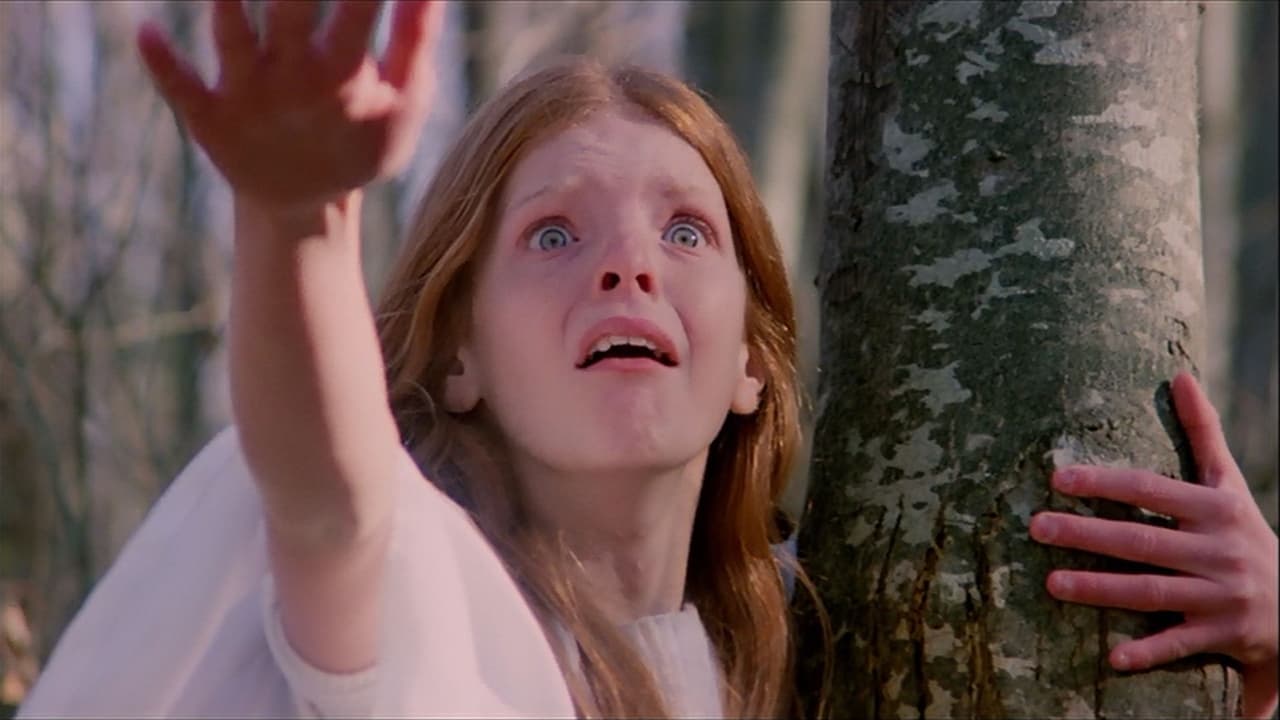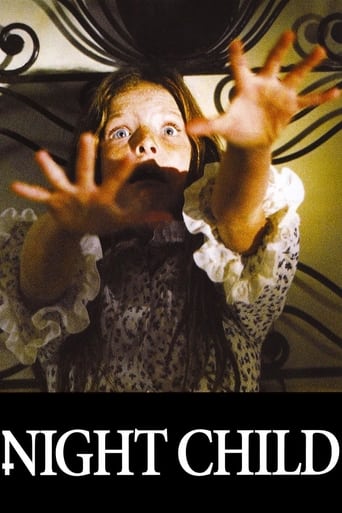

This film is so tame that my kids could have watched it from beginning to end without a problem, if their attention span lasted that long. I think it's rated 15 solely based on the brief appearance of Joanna Cassidy's boob. That said, it's not a total waste of time due to the cast and the man in charge. Poor Emilia (Nicoletta Elmi). Her mum got all burned in a fire then took a header out of a window and now her dad's dragging her to Italy to make a film about the devil. He's played by grumpy Richard Johnson who works for the BBC and has become fascinated with a photograph of a painting sent to him by a local countess. The picture seems to depict the devil, a group of angry pitchfork wielding locals, a young girl and a burning woman falling from the sky.Emilia also has a nanny played by Ida Galli, who is in love with Richard, but her hopes are destroyed when Joanna Cassidy turns up to help out Richard. Joanna Cassidy is famous for playing sexy stripper/killer android Zhora in Blade Runner, so you can see why Richard makes a bee-line for her and ignores his daughter's random flashbacks to a previous life. She also has terrible dreams and screaming fits, which is distracting Richard from getting some.The Countess is also psychic and gets a bad vibe from all this stuff with the painting and some mumbo-jumbo about two medallions, and she herself starts doing a bit of investigating. One 'accidental' death later, things come to a head in an ending I'll admit I didn't see coming, but it takes a while to get there.Some people love this one, probably due to the complete lack of trash and the way the film looks absolutely gorgeous. It does look great - Dallamano's films always do, regardless of content (Venus in Furs), but he can also be a bit too laid back when it comes to plot, and for me that happens here. Although it's refreshing that there's no actual exorcism scenes in the latter half of the film, there's also not much substituted in its place and very little supernatural shenanigans. There's also some terrible blue screen effects, but that's by the by.
... View MoreI have a soft spot in my heart (and maybe my brain pan) for Italian and European "Exorcist" rip-offs, and this is one of the best. It's certainly better than the much more famous "Beyond the Door", which also starred Richard Johnson. Actually,the term "Exorcist" rip-off is a more than a little unfair as these films were all quite different from "The Exorcist" (and each other). This film has a kind of subtle, supernatural atmosphere much more similar to Nicholas Roeg's "Don't Look Now" than to the visceral horror of "The Exorcist". There is also kind of an aura of evil in the film that goes beyond just the possession of the young girl and which anticipates "The Omen" or supernatural Dario Argento films like "Inferno", but with an additional reincarnation element (and, of course, a much more limited budget).This film actually MOST resembles a LATER American film called "Burnt at the Stake" where the young girl imagines herself as the reincarnation of witch who was burned by grotesque villagers. In this movie, the visions of the girl (Nicoletta Elmi) are connected to her mother's "accidental" death by burning, a bizarre painting her father (Richard Johnson) is investigating in Italy for a BBC documentary on the Devil, and to the titular medallion, which belonged to her mother and may have had something to do with her fiery demise. There are definitely some weird connections that a "Don't Look Now"-type psychic in Italy (Lila Kedovra) reveals, and, of course, the Devil himself seems to be involved. But then there are some decidedly Freudian twists at the end that other reviews alluded to. That's what turns out to be the major flaw of this movie--there is just TOO MUCH going on, and while a lot of it is pretty effective, it gets pretty confusing the end is definitely somewhat disappointing.The movie is certainly well-directed by Massimo Dallamano ("What Have You Done to Solange?"), who remains one of Italy's most criminally underrated genre directors. The music, as other reviewers said, is good if perhaps not original (I think I've heard the main score in at least one other movie). Johnson does a reasonably good job as the male lead, and American actress Joanne Cassidy ("Blade Runner") makes a welcome appearance(as do her impressive breasts) as Johnson's agent and love interest. This is an especially good vehicle,however, for Nicoletta Elmi. While most underage actresses, then and now, generally fall into the molds of cute and cloying or teenage and sexy, Elmi was kind of a strange-looking, but actually genuinely talented young actress (not unlike "Burnt at the Stake's" Susan Swift). As in some of her other movies like "Footprints on the Moon" or "Flesh for Frankenstein" (her most famous), Elmi is a sympathetic but also effectively sinister presence here. This isn't a perfect movie,but it's definitely worth seeing.
... View MoreTaihei Yasui's Freudian reading and subsequent criticism of Il Medaglione insanguinato in the previous posting, is undoubtedly interesting. However I do feel it's a bit over ambitious. In many of these Italian genre films Freudian thematics are loose points of departure rather than actual work methods as seen with, say, Arthur Schnitzler or ETA Hoffmann. Furthermore these directors often treated classical dramatic constructions and story line logics very much the same way, that is, as a mere basis for experimenting with the given genre themes. Personally I find this period in European cinema thoroughly refreshing. And to me, Il Medaglione insanguinato certainly is no exception. Logical or not, Freudian or not, it is certainly a psychological thriller but it is draped in the quite appealing aesthetics of an near surrealistic Gothic ghost story. It stands out among it's peers today above all thanks to a beautiful rural cinematography, solemn performances by solid genre stalwarts, and a sublime score. Ultimately Massimo Dallamano's dreamlike direction renders a the film a tragical nightmare-ish tranquility which to me makes the film exceed it's limitations.
... View MoreMichael Williams, who works for BBC, finds a somehow impressive Italian picture which gets mixed in the material of his ongoing task titled DIABOLICAL ART: A DOCUMENTARY. But since his wife's mysterious death her daughter, Emily, has been emotionally disturbed, so he goes Spoleto, where the problematic picture is, with her and her nanny, Jill. And there is a Countess, who is also a psychic, and she informs him that the picture was somehow made at the night that a young witch named Emilia was executed. Michael doesn't believe her story, but after that Emily has hysterical spasm and Jill is killed... This Italian film is, of course, almost innocently influenced by THE EXORCIST, but this one is much cheaper, much simpler,and in a sense, much dirtier. First of all, it should be said this film is full of confusion. For instance, the story shows Emily is a reincarnation of Emilia. But when Emily sees her in the flashbacks, she perceives her exclusively from a third-person's point of view. But if she is the reincarnation of Emilia, she should and must see the past from nothing but Emilia's point of view. Confusions of this kind, which the film has many, are almost exclusively based upon a problematic fact that the film is too cowardly, rather than ambivalent, to specify its own quasi-Freudian theme, namely, pre-adolescent girl's one-way incestuous wish. To make matters worse, this film also has characteristic problem (if not confusion); every character is too naive and helpless to be realistic and/or believable living human. Regarding Emily (or Emilia), she is after all a child, and one can say it is difficult to blame her mainly for her naiveness and helplessness. (And according to the Freudian theory, every girl wants to have her father's child(ren) in her own way. In this sense, Emily is not exclusively pathological; only her way of excluding other women from her father's love is problematically pathological. But, as I already mentioned, this film per se is too cowardly to be Freudian.) The problem is that adult characters are as childish and naive and helpless as Emily is. And because of this characteristic weakness even the psychic who can see almost everything cannot do anything down-to-earth, and because of the same weakness the very story of the film is ended in a badly escapist way. In addition, special effects of this film are incredibly cheap and laughable. Although Stelvio Cipriani's music is noteworthily beautiful (indeed this one is so good that it seems to be worth having it alone), the film as a whole is nothing but a cheap B-film which can disappoint even the 1970s'-Italian- horror-film-lovers.
... View More